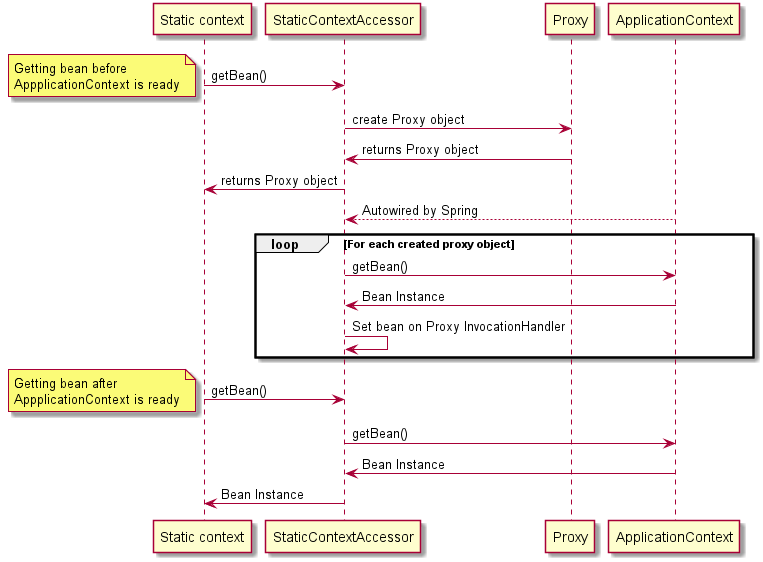Statically Spilling Your (Spring) Beans
- January 24, 2022
- 15878 Unique Views
- 5 min read
UPDATE - To make it abundantly clear:
You should always try to refactor your code so you do not need this approach (something I'll dive into in a follow up blogpost I'm working on). There may be some edge cases where there truly is no other way but those situations are rare. Always try to refactor!
Using this method can lead to multiple unexpected and hard to debug issues as it does not follow the regular Spring Framework concepts. As such, this approach is considered A VERY BAD IDEA.
Continue reading at your own risk! You have been warned!
Autowiring Beans
Getting instances of beans in Spring is pretty simple.
You add @Autowired on your constructor and assuming your class is a bean as well, an instance will be injected in your constructor.
@Component
public class UserServiceImpl implements UserService {
UserRepository repo;
@Autowired
public UserServiceImpl(UserRepository repo) {
this.repo = repo; //JEEJ! an instance!
}
}
Some notes about the above code example before we continue:
- @Autowired can also be placed on a field or a setX(x) method. Constructor injection is generally accepted as the best way to inject dependencies;
- When a class only has a single constructor you can omit the @Autowired annotation (since Spring 4.3), I kept it here for clarity;

The problem
In our use-case, we don't want to create a class. We want to be able to have static access to the beans! This means the standard @Autowire is not an option. There is however another way to get beans, namely directly from the Application Context.
The Application Context is at the heart of the Spring Framework. It provides a couple of different features:
- Load file resources in a generic fashion;
- Publish events to registered listeners;
- Resolve messages, supporting internationalization;
- It has bean factory methods for accessing application components;
That last one is what we are interested in. We want to use the Application Context to get another bean. The ApplicationContext interface provides a nice convenient method to access beans it knows about: getBean(Class)?
// Our static method
public static <T> T getBean(Class<T> clazz) {
ApplicationContext context = //excluded
return context.getBean(clazz);
}
So all we need now is to get an ApplicationContext and we are done! How do we get one? Well, you could @Autowire one... but we want to use it in a static context. Here is how we can do it!
@Component
public class StaticContextAccessor {
private static ApplicationContext context;
@Autowired
public StaticContextAccessor(ApplicationContext applicationContext) {
context = applicationContext;
}
public static <T> T getBean(Class<T> clazz) {
return context.getBean(clazz);
}
}
- Create a class marked with @Component. This way, Spring will initialize it on startup by default.
- @Autowire the ApplicationContext.
- Set the ApplicationContext to a static field.
- static method can now use the ApplicationContext.
Doing this, we can now use the getBean() method on the StaticContextAccessor to get any bean in a static context.
UserRepository userRepo = StaticContextAccessor.getBean(UserRespository.class)

Timing and the looming NullPointerException
While the solution above works, there is a major problem with it. It is possible to use the StaticContextAccessor.getBean(class) method before the ApplicationContext is autowired. This would crash the system because you can't invoke a method on a reference pointing to null.

We have a timing issue here. We know the ApplicationContext will be autowired eventually, usually within seconds if not milliseconds after the application is started. But we also can't really stop anyone from invoking the static method to get the bean before that happens.
Returning a Proxy
To avoid the timing issue, we need to bridge the time between those two events. What we could do is provide a temporary object, so our static getBean() returns at least something. This can be achieved by using a Proxy object, which is a part of the Java specification.
A proxy class is a class created at runtime that implements a specified list of interfaces, known as proxy interfaces. A proxy instance is an instance of a proxy class. Each proxy instance has an associated invocation handler object, which implements the interface InvocationHandler. A method invocation on a proxy instance through one of its proxy interfaces will be dispatched to the invoke method of the instance's invocation handler, passing the proxy instance, a java.lang.reflect.Method object identifying the method that was invoked, and an array of type Object containing the arguments. Source: https://docs.oracle.com/en/java/javase/17/docs/api/java.base/java/lang/reflect/Proxy.html
So we need a couple of things now. Let's start by creating the Proxy object.
public static <T> T getBean(Class<T> clazz) {
if (context == null) {
return getProxy(clazz);
}
return context.getBean(clazz);
}
private static <T> T getProxy(Class<T> clazz) {
// Our custom invocation handler, will be explained below!
DynamicInvocationhandler<T> invocationhandler = new DynamicInvocationhandler<>();
return (T) Proxy.newProxyInstance(
clazz.getClassLoader(),
new Class[]{clazz},
invocationhandler
);
}
The Proxy.newProxyInstance() method will return a dynamic object of the given interface. It creates a new Object, at runtime, which extends Proxy and implements the given interface. Since this object implements the given interface, we can return it in our getBean() method. Thanks Polymorphism!
Note: This method will only work when requesting a interface. If you want to be able to create a proxy-object for non-interfaces, you could use ByteBuddy. ByteBuddy is out of the scope of this post.
Next up is the InvocationHandler. Whenever a method is invoked on our proxy object, the invoke method of this handler will be called. If your handler has the actual bean set, it will invoke the correct method on our bean instance. If the actual bean isn't set yet, it will throw a RuntimeException().
class DynamicInvocationhandler<T> implements InvocationHandler {
private T actualBean;
public void setActualBean(T actual) {
this.actualBean = actual;
}
@Override
public Object invoke(Object proxy, Method method, Object[] args) throws Throwable {
if (actualBean == null) {
throw new RuntimeException("Not initialized yet! :(");
}
return method.invoke(actualBean, args);
}
}
Now all that is left is to set the actual bean on the handler as soon as it becomes available and we are done!

Full Code Solution
@Component
public class StaticContextAccessor {
private static final Map<Class, DynamicInvocationhandler> classHandlers = new HashMap<>();
private static ApplicationContext context;
@Autowired
public StaticContextAccessor(ApplicationContext applicationContext) {
context = applicationContext;
}
public static <T> T getBean(Class<T> clazz) {
if (context == null) {
return getProxy(clazz);
}
return context.getBean(clazz);
}
private static <T> T getProxy(Class<T> clazz) {
DynamicInvocationhandler<T> invocationhandler = new DynamicInvocationhandler<>();
classHandlers.put(clazz, invocationhandler);
return (T) Proxy.newProxyInstance(
clazz.getClassLoader(),
new Class[]{clazz},
invocationhandler
);
}
//Use the context to get the actual beans and feed them to the invocationhandlers
@PostConstruct
private void init() {
classHandlers.forEach((class, invocationHandler) -> {
Object bean = context.getBean(class);
invocationHandler.setActualBean(bean);
});
}
static class DynamicInvocationhandler<T> implements InvocationHandler {
private T actualBean;
public void setActualBean(T actualBean) {
this.actualBean = actualBean;
}
@Override
public Object invoke(Object proxy, Method method, Object[] args) throws Throwable {
if (actualBean == null) {
throw new RuntimeException("Not initialized yet! :(");
}
return method.invoke(actual, args);
}
}
}
There we go! We can now get Spring components from a static context!
All we need to do is call the static getBean method.
UserRepository userRepo = StaticContextAccessor.getBean(UserRespository.class)
About that RuntimeException
Even with this proxying setup, there is still a case which will not work.
As you can see in the handler code above, if the actualBean isn't set yet, we throw a RuntimeException.
UserRepository userRepo = StaticContextAccessor.getBean(UserRespository.class) userRepo.getAll() //this will break if called before ApplicationContext is ready.
There is no way around this. If the bean isn't created and known in the ApplicationContext, we can't call a method on it. The proxy solves the issue with the time between requesting the Bean and the ApplicationContext being created. However, if the real bean isn't loaded into the proxy and a method is invoked, the only option is to throw an exception.
Don’t Forget to Share This Post!








Comments (4)
Jan Thewes
3 years agoWell in this case returning an ObjectFactory or a javax.inject.Provider would be easier and be more expressive, or am I wrong?
Magnus
3 years agoHow about wrapping in a completablefuture that completes only when the bean is available
Rumen
3 years agoI fully agree that returning a Promise (https://java-design-patterns.com/patterns/promise/) is the right way to close this case.
Dmitrii
3 years agoIt's not thread safe though. If you try to access your invocation handler from another thread than context is set then you may get visibility problem. It will cause RuntimeException even after context is fully loaded. More over, it also affects the HashMap which is not thread safe.